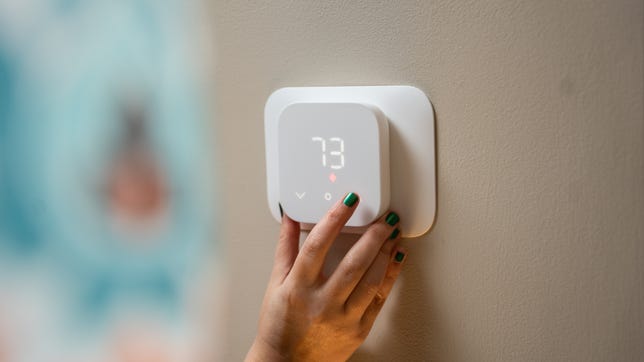 Why You Can Trust CNET
Why You Can Trust CNET Amazon Smart Thermostat review: A steal at $60
This Editors' Choice award winner has everything you need to adjust your heat and AC for not much money.
Like
- Excellent price
- Seamless integration with the Alexa app and Alexa voice commands
- Attractive design
- Responsive touchscreen interface
Don't like
- Doesn't work with Google Assistant or Apple HomeKit
- If you don't have a C-wire, you have to install the C-wire adapter
- No remote temperature sensor
Amazon's $60 Smart Thermostat sets a new standard for the category. It has a clean, modern touchscreen design, and it's easy to use, whether you're adjusting the temperature at the thermostat, through the Alexa app or with Alexa voice commands. You do need a compatible smart speaker or display for the voice control part, though. More on that later.
The Amazon Smart Thermostat is also the least expensive smart thermostat I've ever tested. Even the Wyze Thermostat costs more, and that brand is known for its low-priced home products.
This model doesn't work with Google Assistant or Apple HomeKit -- and it either requires a C-wire or a C-wire adapter to operate. Amazon sells two different product bundles for this reason, the standard $60 model with just the thermostat and a $75 version that comes with a C-wire adapter.
For 60 bucks, the CNET Editors' Choice-award-winning Amazon Smart Thermostat offers the absolute best value of any smart thermostat out there today. It looks nice, it works well and it offers a variety of smart features through the app and with Alexa commands. I strongly recommend it if you're looking for a solid smart thermostat at a great price.
Getting started
Because Amazon sells the C-wire adapter in a separate product bundle, you'll want to double-check your HVAC system's compatibility with the Amazon Smart Thermostat before you buy. Amazon also sells the C-wire adapter separately for $25.
My system has a C-wire (learn more about C-wires), so I opted for the standard $60 option without the adapter. That purchase includes the thermostat, as well as an optional wall plate to cover any old paint or holes from previous thermostats. You also get mounting hardware, a small screwdriver for the installation and a little instruction manual. Hang onto the booklet because you'll need to scan the QR code on the back as part of the installation process.
Next, download the Alexa app and create an account -- or sign in if you already have one. Then select Devices > Add device > Thermostat > Amazon.
Like other smart thermostats I've tested, the Alexa app walks you through the steps to install and configure your Amazon Smart Thermostat. It helps you confirm your wiring, connect to the Wi-Fi network and answer various other questions about the type of HVAC system you have. Note: Always consult an electrician if you have questions about your HVAC system.
The installation and configuration process took me about 10 minutes. Because I install a lot of smart thermostats in the same spot, I already had holes drilled that lined up with this model. My thermostat wiring already included a C-wire, too, so it might take you a bit longer to install the Amazon Smart Thermostat if you need to install the C-wire adapter or drill new holes. Another time-saver: You don't have to separately enable an Alexa skill for this thermostat since it's already an Amazon-branded product.
View and control your thermostat on an Alexa-enabled smart display like this Echo Show 8.
Testing and things
Once everything is installed and configured, you're ready to start using your thermostat.
This model can either rely on a specific fixed schedule that you create in the app or through something called Hunches. Hunches use your phone's location to automatically update the temperature for you. You can set preferred temperatures for Home, Away and Sleep modes and then, based on your phone's location, Hunches will make adjustments if you're home or away.
The Hunches feature consistently set the temperature to home or away for me -- and you can add additional users if you have multiple people living with you.
You have to give Alexa permission to track your location to use Hunches.
You can also control the temperature in the app, using Alexa voice commands or directly on the thermostat itself.
All three of these options worked extremely well during my testing. The thermostat's touch display has simple up and down arrows for adjusting the temperature. A button in the middle lets you switch between heat, air conditioning, the fan and other basic settings.
In the app you have even more options. That's where you can set a custom schedule, check on the energy consumption of your device over time along with any other compatible Alexa devices you might have -- and all of the basics like adjusting the temperature or changing the mode from heat to AC.
Adjust the temperature in the Alexa app.
You can also use Alexa voice commands to control the thermostat. I used an Echo Show 8 smart display, so I was both able to ask Alexa to turn on the heat or to set the heat to 68 degrees, as well as view and control the thermostat via the smart display screen itself. You can also create scenes (they're called "Routines" in the Alexa app) such as "good morning" to automatically adjust a variety of devices including your smart thermostat at one time; you could turn on the lights, open the shades and set the thermostat to a specific temperature with that one voice command.
The competitor landscape
It's a bit tricky to talk about major smart thermostat competitors like Nest and Ecobee here because all of their thermostats cost well over $100. Some even retail for as much as $250.
With Nest, especially the flagship Nest Learning Thermostat, you're really paying a premium for the product design. The $250 Learning Thermostat is made with stainless steel and has a substantial, luxury feel. Nest's two other thermostats -- the Nest Thermostat E (available through dealers) and the newer Nest Thermostat (not to be confused with the Nest Learning Thermostat) -- have similar designs but use less expensive materials. Nest sells temperature sensors separately for $39 each.
Ecobee excels at features, especially voice integrations. Its $250 Ecobee Smart Thermostat with Voice Control even has a built-in Alexa speaker, so you don't need a separate Alexa-enabled smart speaker or display to control it with voice commands. It's also compatible with Google Assistant and Apple HomeKit, but you need separate speakers for that. That purchase also includes a remote temperature sensor. The $180 Ecobee 3 Lite loses the built-in Alexa speaker and the remote temperature sensor, but still works with Alexa, Google Assistant and HomeKit.
It's interesting that the Amazon Smart Thermostat was designed in concert with Resideo. Resideo makes Honeywell Home products, including the Honeywell Home T9 Smart Thermostat, which costs $200 with the included remote sensor. I prefer the T9's temperature sensor over Nest's and Ecobee's because it offers the most options -- temperature, humidity and proximity sensing.
While the Amazon Smart Thermostat and the Honeywell Home T9 have different designs, Amazon's version reminds me of some of Honeywell Home's older models, especially the square Lyric T5 thermostat.
The $71 Wyze Thermostat is the closest competitor to Amazon's Smart Thermostat. Wyze is a Seattle-based company that sells a variety of home products at affordable prices. Some of those products outperform more expensive models, like the Wyze Bulb and the Wyze Cam. In this case, the Amazon Smart Thermostat has more to offer, particularly in terms of hardware design, because the Wyze Thermostat's control dial was difficult to use.
An excellent value
The Amazon Smart Thermostat sets a new benchmark for connected thermostats. Its simple controls, solid design and streamlined Alexa integrations make it stand out, but it's the $60 price tag that truly sets it apart.
If you're looking for premium design, the Nest Learning Thermostat is still your best bet. If you want the widest variety of smart home integrations, Ecobee's SmartThermostat with Voice Control is an excellent choice. The Honeywell Home T9 has the smartest remote sensor (it tracks temperature, humidity and proximity). But if you're looking for a well-rounded smart thermostat at an excellent price, the Amazon Smart Thermostat is the best option on the market today.
I don't like that the C-wire adapter is sold in a separate bundle. I'd also like to see integrations with Google Assistant and Apple HomeKit. A remote sensor accessory would be nice, too. That said, for 60 bucks, you really can't beat the value of this Editors' Choice award-winning smart thermostat.
Solar Installer Guides
Best Solar Products and Companies
Solar Installers by State
Solar Installers
Solar Resources and Guides


